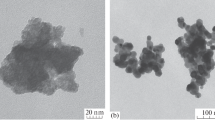Abstract
The thermal conductivity of dense and porous yttria-stabilized zirconia (YSZ) ceramics has been measured as a function of temperature in the range 25 to 1000 °C. The dense specimens were either single crystal (8 mol% YSZ) or sintered polycrystalline (3 mol% and 8 mol% YSZ). The porous specimens (3 mol% YSZ) were prepared using the “fugitive” polymer method, where different amounts of polymer spheres (of two different average sizes) were included in the starting powders before sintering. This method yielded materials with uniformly distributed porosities with a tight pore-size distributions. A theory has been developed to describe the thermal conductivity of dense YSZ as a function of temperature. This theory considers the reduction in the intrinsic thermal conductivity due scattering of phonons by point defects (oxygen vacancies and solute) and by the “hopping” of oxygen vacancies. It also considers an increase in the effective thermal conductivity at high temperatures due to radiation. This theory captures the essential features of the observed thermal conductivity. The Maxwell theory has been used to analyze the thermal conductivity of the porous materials. An adequate agreement was found between the theory and experiment.
Similar content being viewed by others
References
W. D. Kingery, H. K. Bowen and D. R. Uhlmann, “Introduction to Ceramics” (Wiley Interscience, New York, 1976).
R. L. Jones, in “Metallurgical and Ceramic Coatings,” edited by K. H. Stern (Chapman & Hall, London, 1996) p. 194.
R. J. Bratton and S. K. Lau, in “Advances in Ceramics: Science and Technology of Zirconia,” Vol. 3, edited by A. H. Heuer and L. W. Hobbs (The American Ceramic Society, Columbus, OH, USA, 1981) p. 226.
K. D. Sheffler and D. K. Gupta, J. Eng. Gas Turbines and Power (Trans. ASME) 110 (1988) 605.
S. M. Meier, D. K. Gupta and K. D. Sheffler, J. Metals 43 (1991) 50.
R. C. Novak, A. P. Matarese, R. P. Huston, A. J. Scharman and T. M. Yonushonis, Mater. Manuf. Processes 7 (1992) 15.
H. E. Eaton, J. R. Linsey and R. B. Dinwiddie, in “Thermal Conductivity 22,” edited by T. W. Tong (Technomic, Lancaster, PA, USA, 1994) p. 289.
R. Mcphearson, Thin Solid Films 112 (1984) 89.
J.-M. Dorvaux, O. Lavigne, R. Mevrel, M. Poulain, Y. Renollet and C. Rio, in Proceedings of the 85th Meeting of the AGARD Structures and Materials Panel, Neuilly-sur-Seine, France, 1998, Vol. R-823, edited NATO and AGARD, p. 13.
D. P. H. Hasselman, L. F. Johnson, L. D. Bentsen, R. Syed, H. L. Lee and M. V. Swain, Am. Ceram. Soc. Bull. 66 (1987) 799.
G. E. Youngblood, R. W. Rice and R. P. Ingel, J. Amer. Ceram. Soc. 71(4) (1988) 255.
S. Raghavan, H. Wang, R. B. Dinwiddie, W. D. Porter and M. J. Mayo, Scripta Mater. 39(8) (1998) 1119.
P. G. Klemens, in “Thermal Conductivity 23,” edited by K. E. Wils, R. B. Dinwiddie and R. S. Graves (Technomics Publishing Co., Lancaster, PA, USA, 1996) p. 209.
Idem., in “Chemistry and Physics of Nanostructures and Related Non-Equilibrium Materials,” edited by E. Ma, B. Fultz, R. Shull, J. E. Morral and P. Nash (TMS, Warrendale, PA, USA, 1997) p. 87.
J. Zhao and M. P. Harmer, J. Amer. Ceram. Soc. 70 (1988) 449.
E. C. M. Pennings and W. Grellner, ibid. 72 (1989) 1268.
R. E. Taylor and K. D. Maglic, in “Compendium of Thermophysical Property Measurement Methods,” Vol. 1, edited by K. D. Maglic, A. Cezairliyan and V. E. Peletsky (Plenum Press, New York, NY, USA) 1984.
K. D. Maglic and R. E. Taylor, in “Compendium of Thermophysical Property Measurement Methods,” Vol. 2, edited by K. D. Maglic, A. Cezairliyan and V. E. Peletsky (Plenum Press, New York, NY, USA) 1992.
P. G. Klemens, in “Thermal Conductivity,” Vol. 1, edited by R. P. Tyne (Academic Press, London, UK, 1969) p. 1.
Y. S. Touloukian, R. W. Powell, C. Y. Ho and P. G. Klemens, “Thermophysical Properties of Matter: Vol. 2, Thermal Conductivity” (Plenum, New York, NY, USA, 1970).
P. G. Klemens, Phys. Rev. 119 (1960) 507.
Idem., Physica B 263-264 (1999) 102.
W. M. Rogers and R. L. Powell, NBS Circular 595 (1958) 1.
D. L. Wood and K. Nassau, Applied Optics 21 (1982) 2978.
J. E. Parrott and A. D. Stuckes, “Thermal Conductivity of Solids” (Pion Ltd., London, UK, 1975).
J. C. Maxwell, “A Treatise on Electricity and Magnetism” (Clarendon Press, Oxford, UK, 1904).
P. G. Klemens, High Temps.-High Press. 23 (1991) 241.
K. W. Schlichting, N. P. Padture and P. G. Klemens, in “Thermal Conductivity 25,” edited by C. Uher and D. Morelli (Technomic, Lancaster, PA, USA, 2000) p. 162.
Author information
Authors and Affiliations
Rights and permissions
About this article
Cite this article
Schlichting, K.W., Padture, N.P. & Klemens, P.G. Thermal conductivity of dense and porous yttria-stabilized zirconia. Journal of Materials Science 36, 3003–3010 (2001). https://doi.org/10.1023/A:1017970924312
Issue Date:
DOI: https://doi.org/10.1023/A:1017970924312



